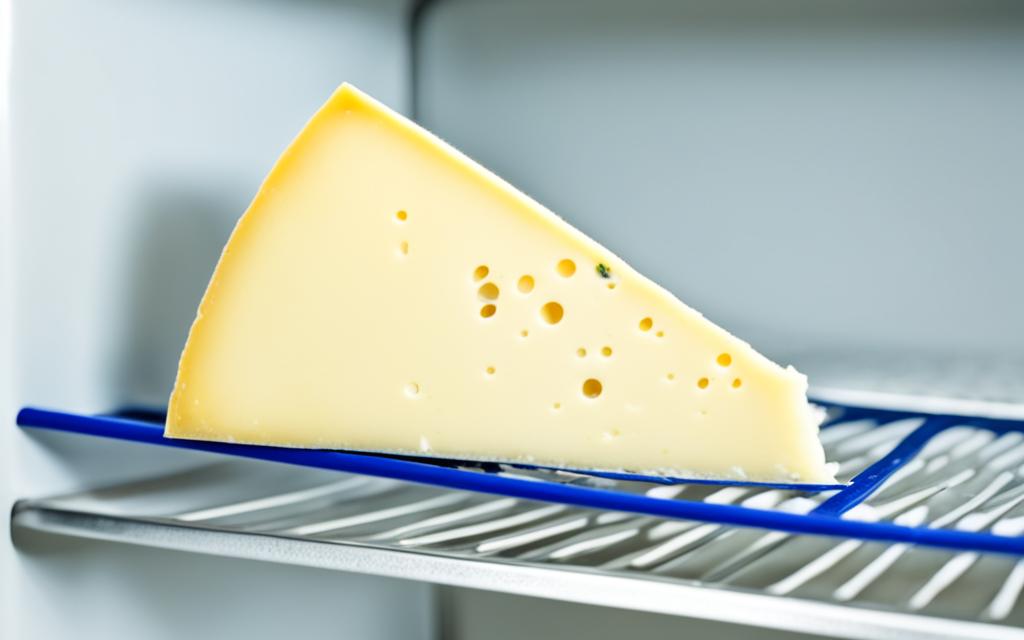As a cheese enthusiast, you know the joy of indulging in a variety of flavorful, creamy cheeses. But have you ever wondered how long your favorite cheese can last in the fridge? Proper storage is key to maximizing the shelf life of your dairy delights. In this comprehensive guide, we’ll explore the typical lifespan of different types of cheese and share expert tips on keeping them fresh for longer.
Whether you’re a connoisseur or simply looking to get the most out of your cheese purchases, this article has you covered. We’ll dive into the factors that affect cheese shelf life, reveal the signs that cheese has gone bad, and even share creative ways to use up any leftover cheese before it spoils. With this knowledge, you’ll be able to properly store cheese and savor the flavors of your favorite dairy products for as long as possible.
So, let’s embark on a cheesy adventure and uncover the secrets to maximizing the how long does cheese last in the fridge. Get ready to elevate your cheese game and never let a morsel go to waste!
Understanding Cheese Shelf Life
The cheese shelf life can vary greatly depending on several factors, including the type of cheese, how it was made, and how it’s stored. In general, harder, aged cheeses like cheddar, parmesan, and gouda tend to last longer than soft, fresh cheeses like mozzarella or ricotta. The aging process helps preserve harder cheeses, while softer varieties have a shorter window of peak freshness. Proper storage techniques, such as keeping cheese wrapped in parchment or wax paper and stored in the coldest part of the refrigerator, can also extend its shelf life.
The factors affecting cheese shelf life include the moisture content, fat content, and the presence of preservatives or additives. Harder, lower-moisture cheeses typically have a longer shelf life compared to softer, higher-moisture varieties. Additionally, the way the cheese is produced, such as the type of milk used, the aging process, and the addition of cultures or flavorings, can all impact its shelf life.
When it comes to the types of cheese and their shelf life, it’s important to understand the differences. Hard cheeses like parmesan and cheddar can last for 3-6 months in the refrigerator, while semi-hard cheeses like Swiss and provolone may last 2-4 months. Soft cheeses, such as brie and camembert, generally have a shorter shelf life of 1-2 weeks, and fresh cheeses like ricotta and cottage cheese can last for 1-2 weeks.
Proper Cheese Storage Techniques
To get the most out of your cheese, it’s important to store it properly. Wrap hard, semi-hard, and soft cheeses individually in parchment paper, wax paper, or cheese paper to allow for airflow while preventing the cheese from drying out. Soft cheeses should be stored in an airtight container. Maintain an optimal storage temperature between 35°F and 40°F, and aim for a humidity level between 80-90%. Avoid storing cheese in the door of the refrigerator, as the temperature fluctuations can negatively impact freshness.
Proper cheese storage techniques are crucial for extending the shelf life of your favorite dairy products. By controlling the temperature and humidity levels and wrapping each cheese appropriately, you can ensure your cheese stays fresh and flavorful for longer.
| Storage Tip | Rationale |
|---|---|
| Wrap in parchment or wax paper | Allows for airflow while preventing drying |
| Store in airtight container (soft cheeses) | Retains moisture and prevents contamination |
| Maintain 35°F to 40°F temperature | Optimal range for preserving cheese quality |
| Aim for 80-90% humidity | Prevents cheese from drying out or becoming moldy |
| Avoid refrigerator door storage | Temperature fluctuations can negatively impact freshness |
By following these cheese storage techniques, you can maximize the shelf life of your favorite dairy products and enjoy their full flavor and texture for longer.
How Long Does Cheese Last in the Fridge?
The shelf life of cheese can vary significantly depending on the type. Here’s a general guideline for how long different cheeses will typically last in the refrigerator:
| Cheese Type | Typical Shelf Life |
|---|---|
| Hard Cheeses (cheddar, parmesan, etc.) | 3-6 months |
| Semi-Hard Cheeses (Swiss, provolone, etc.) | 2-4 months |
| Soft Cheeses (brie, camembert, etc.) | 1-2 weeks |
| Fresh Cheeses (ricotta, cottage cheese, etc.) | 1-2 weeks |
Proper storage techniques, such as wrapping and maintaining optimal temperature and humidity, can help extend the shelf life of your cheese. It’s important to regularly inspect your cheese and discard any that show signs of spoilage.
Signs That Cheese Has Gone Bad
When it comes to determining if your cheese has gone bad, it’s important to be vigilant and trust your senses. Visual cues like mold growth, discoloration, or a slimy or dried-out texture can be clear signs that the cheese has spoiled. Additionally, an off-putting, sour, or ammonia-like odor is a telltale sign that the cheese is no longer fit for consumption.
If your cheese exhibits any of these undesirable characteristics, it’s best to err on the side of caution and discard it. Consuming spoiled cheese can lead to foodborne illness, so it’s crucial to stay alert and take action as soon as you notice the signs that cheese has gone bad. Paying close attention to the appearance and aroma of your cheese can help you avoid any potential risks to your health.
Reviving and Rescuing Stale Cheese
If your cheese has started to dry out or become hard, you may be able to revive it with a few simple techniques. For hard, aged cheeses like cheddar or parmesan, try grating or shredding the affected areas and mixing them into dishes like mac and cheese, quiche, or grilled cheese sandwiches. The heat and moisture from the other ingredients can help soften the hard or stale cheese.
For soft cheeses that have started to lose their moisture, you can try wrapping them in a damp paper towel or cheesecloth and refrigerating for a few hours to rehydrate. This simple technique for restoring dry or hard cheese can help bring back the creamy, supple texture.
However, it’s important to avoid attempting to revive moldy cheese, as that can be unsafe to consume. If your cheese has developed any signs of mold growth, it’s best to discard it and start fresh.
Maximizing Cheese Shelf Life
To get the most out of your cheese purchases, follow these tips for maximizing their shelf life:
First, store hard and semi-hard cheeses wrapped in parchment or wax paper in the coldest part of the fridge. This helps prevent drying and maintains their optimal texture and flavor. For soft cheeses, keep them in an airtight container to prevent them from drying out.
If you find yourself with excess cheese, consider freezing it for long-term storage. Hard and semi-hard cheeses can typically be frozen for 6-8 months, while soft cheeses may only last 1-2 months in the freezer. To make thawing and using the frozen cheese easier, grate, shred, or cube it before freezing.
| Cheese Type | Freezer Storage Life |
|---|---|
| Hard and Semi-Hard | 6-8 months |
| Soft | 1-2 months |
By following these tips for storing different cheese types and taking advantage of the freezer, you can maximize the shelf life of your favorite cheeses and enjoy them at their best for longer.
Creative Ways to Use Up Leftover Cheese
Don’t let that last bit of cheese go to waste! There are plenty of creative ways to repurpose leftover cheese in delicious dishes. Try adding shredded or crumbled cheese to omelets, quiches, mac and cheese, or casseroles. Cubed or crumbled cheese also makes a great addition to salads, soups, and pasta.
For those harder cheeses nearing the end of their shelf life, you can even melt them down to make a cheese sauce or fondue. And for soft cheeses that are starting to show their age, spread them on crackers, crostini, or use them as a topping for burgers or grilled sandwiches.
With a little creativity, you can transform those last scraps of cheese into delicious, satisfying meals and snacks, ensuring you get the most out of your dairy purchases. Don’t let those recipes using up leftover cheese go to waste!
Conclusion
In this guide, we’ve covered everything you need to know about maximizing the shelf life of your favorite cheeses. From understanding the factors that affect cheese freshness to recognizing the signs of spoilage, you’re now equipped with the knowledge to store your cheese properly and get the most out of your purchases. Remember to always inspect your cheese before consuming it, and don’t hesitate to get creative with ways to use up any leftover bits. With these tips, you can enjoy delicious, fresh cheese for longer.
Whether you’re a cheese connoisseur or just looking to get the most out of your dairy purchases, this guide has provided you with the information you need to how long does cheese last in the fridge, implement the best cheese storage tips, and find innovative ways to utilize any leftover cheese before it spoils. By following these strategies, you’ll be able to savor the flavor and quality of your favorite cheeses for weeks, if not months, to come.
So don’t let your cheese go to waste – put these techniques into practice and enjoy the delicious, long-lasting results. Happy cheese-eating!










